V6.9.0 (July 2025 Release)
Welcome to the July edition of our platform updates! At Qyrus, our mission is to constantly evolve our platform, providing your teams with powerful, intuitive tools that streamline every phase of the quality lifecycle. This July, we’ve been laser-focused on delivering enhancements that bring you deeper workflow integrations, next-level AI automation, and foundational improvements to security and performance. These updates are designed to connect your existing tools seamlessly, accelerate test creation like never before, and give you even greater confidence in your testing environment.
Let’s explore the powerful new features we’ve rolled out across the Qyrus platform this July!
New Feature
Unleash Iterative Power: Now Create Loops Inside Your Functions!
The Problem:
Previously, users could not place a loop inside a function. This meant that any reusable logic requiring iteration over data or web elements could not be encapsulated within a single, self-contained function. Users would have to build the loop structure outside the function, making the test less modular and harder to read.
The Fix:
Support for loops within functions has been introduced for Web Testing. Users can now create loops directly inside a function’s logic, allowing them to perform iterative actions within the function’s context. However, to prevent potential infinite loops or overly complex structures, a function that contains a loop cannot itself be placed inside another loop.
How does it help?
This enhancement significantly improves the power and modularity of functions. Users can now create more complex and self-contained reusable components that handle their own iterative logic (e.g., a function to process all rows in a specific table). This leads to cleaner, more organized test scripts, reduces code duplication, and makes sophisticated, repeatable actions easier to build and maintain.
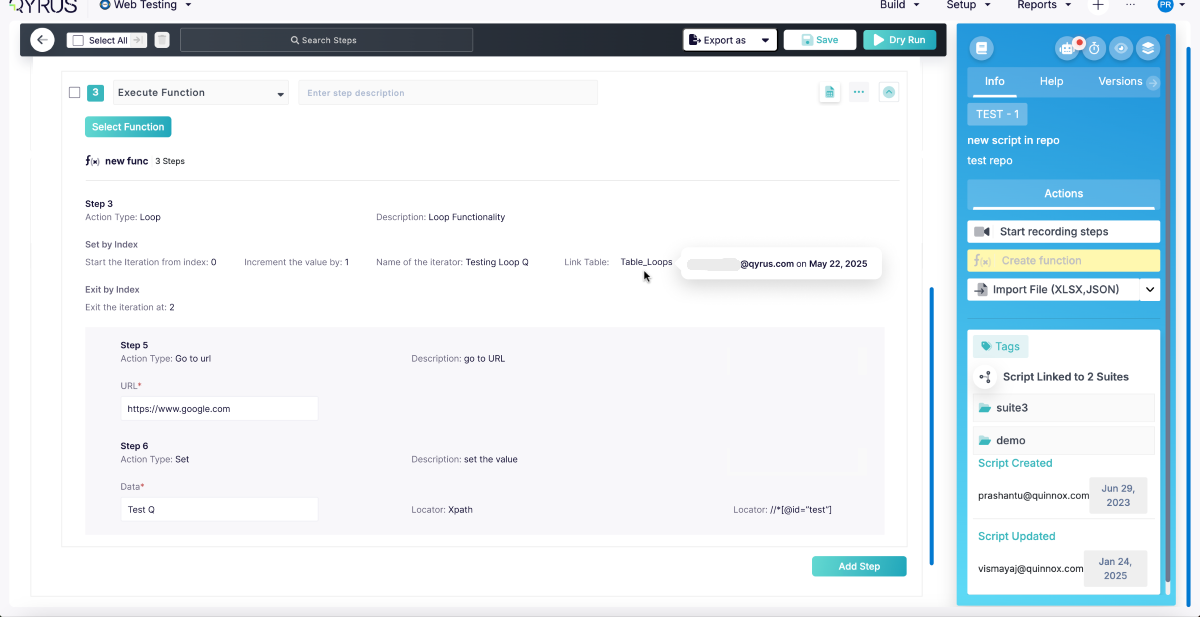
Improvement
Your Secrets Are Safe: Enhanced Password Security in Reports
The Problem: Previously, all variable values are visible in plaintext, even variables designated as a ‘Password.’ Users have requested that this field is masked to ensure that sensitive data is not visible in reports.
The Fix:
To eliminate this, we have implemented an update. The system now automatically identifies any global variable of the ‘password’ type and ensures its value is masked, preventing it from appearing in any execution reports.
How Does it Help?
This enhancement significantly hardens the security of your test reporting process. You can now confidently use password-type global variables for your Desktop Testing automation, knowing that these sensitive credentials will remain protected and will not be exposed in any reports, ensuring better compliance and peace of mind.
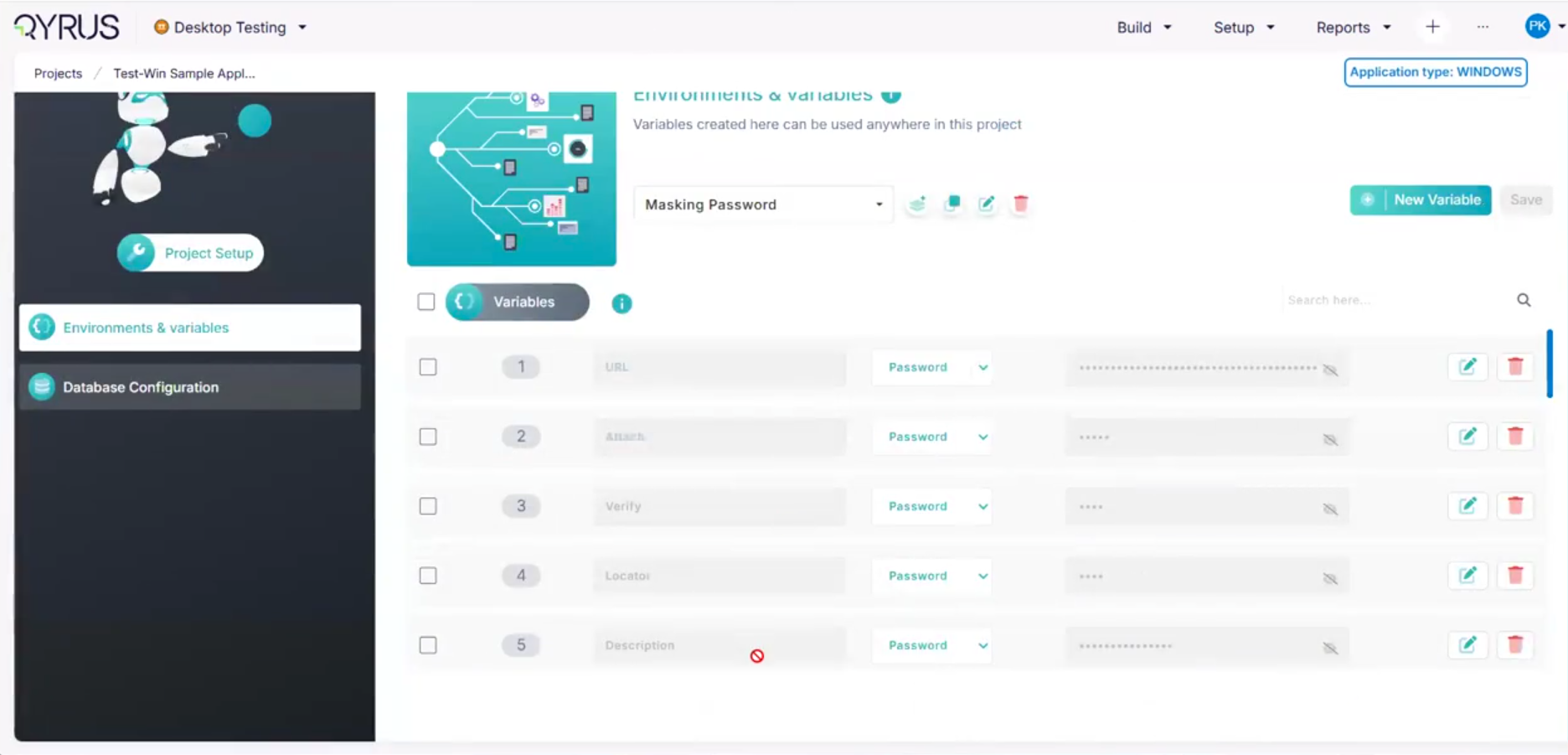
Improvement
PDF Reports, Faster Than Ever!
The Problem: The process for generating PDF reports, especially for large or complex test executions, could sometimes be slower than desired. This background process, had room for improvement to ensure reports were created and delivered as quickly and efficiently as possible.
The Fix: We have completed a significant refactoring of the function responsible for generating PDF reports. The underlying code has been thoroughly optimized to improve its processing speed and efficiency without changing the final report’s appearance or content.
How does it help? This optimization directly translates to enhanced performance, meaning your PDF reports will now be generated noticeably faster. This improvement is especially beneficial for large test suites, as it reduces the waiting time for your final, shareable reports and increases the reliability of the report generation process.

New Feature
Stay Logged In: Introducing Session Persistence in Test Orchestration!
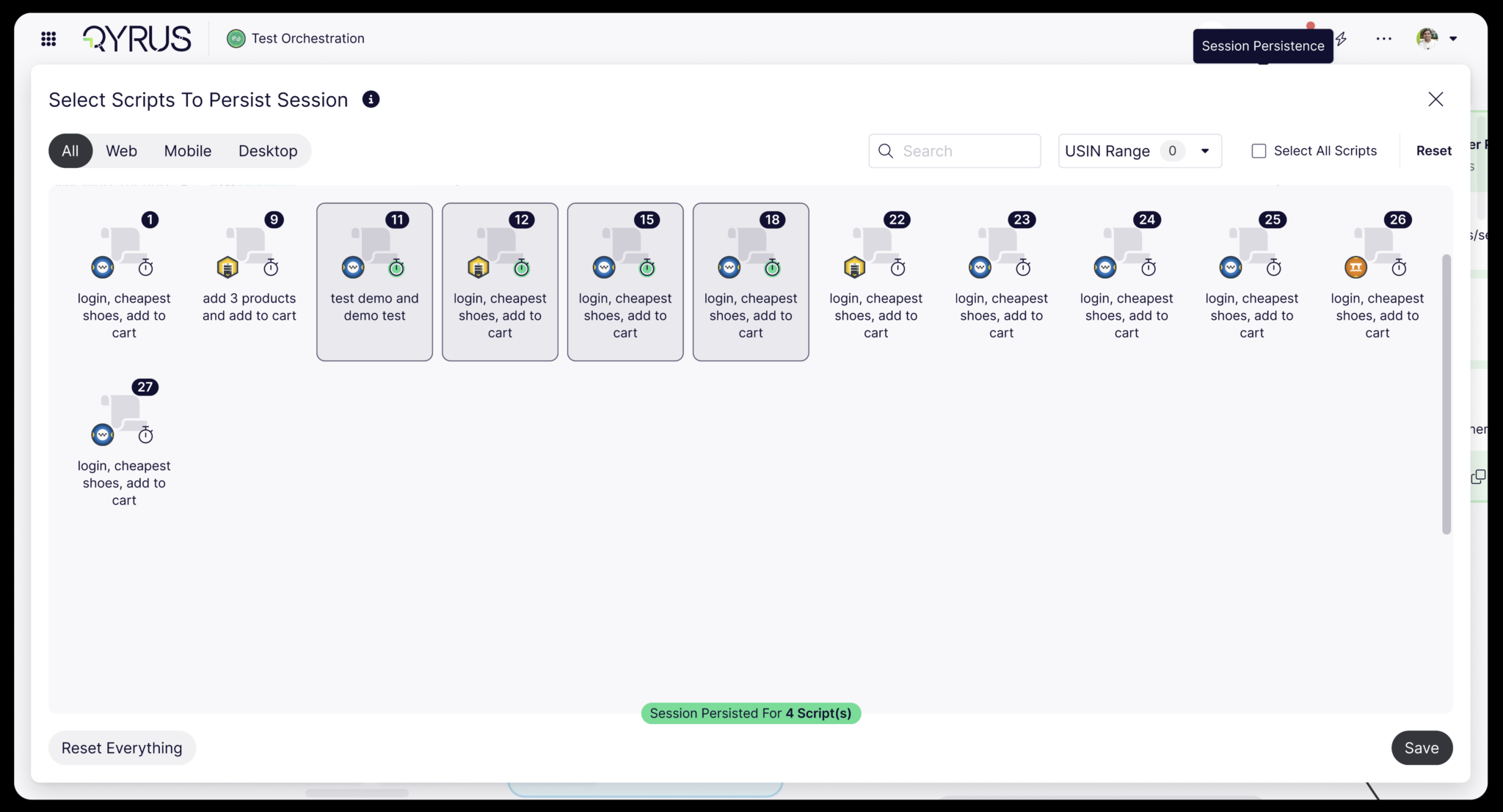
The Problem:
Previously, when running a sequence of test cases in Test Orchestration, each test would typically start with a fresh session. This made it challenging to execute true end-to-end (E2E) test scenarios that required a continuous, logged-in state or maintained context to flow from one test case to the next, often forcing users to repeat login or setup steps in every script.
The Fix: Test Orchestration now supports session persistence for both web and mobile nodes. This feature can maintain a continuous session for up to 24 hours across multiple test cases within a single workflow.
How does it help?
This is a game-changer for end-to-end testing. Users can now build and run complex workflows where the application state and user session are seamlessly carried over from one test case to the next. This eliminates redundant login steps, simplifies the creation of sophisticated E2E scenarios (like adding an item to a cart in one test and checking out in another), and makes your testing more efficient and powerful.
Improvement
Your Reports, Anywhere: Introducing Portable Offline HTML Reports!
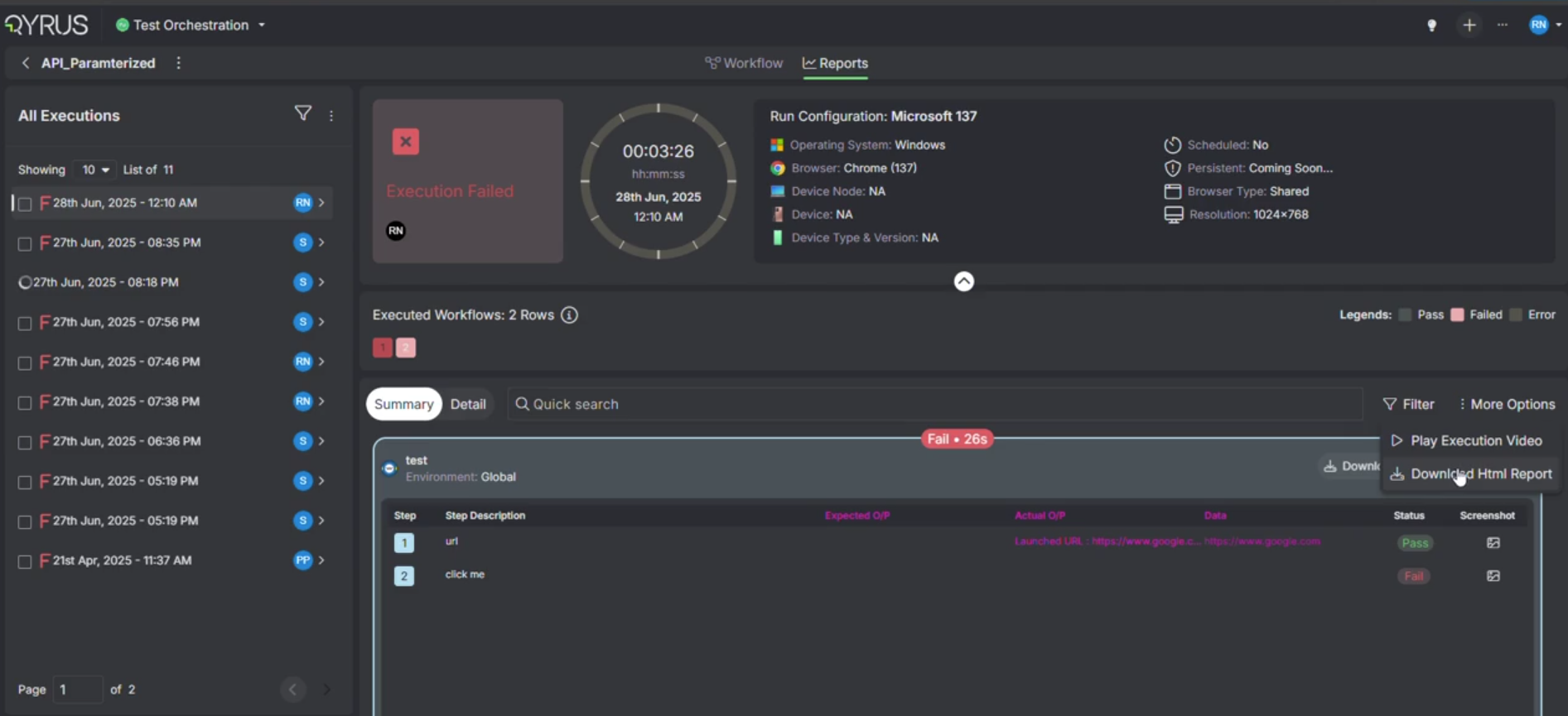
The Problem: Previously, reviewing or sharing detailed test results from Test Orchestration could require an active internet connection to access the platform. There was a need for a simple, comprehensive reporting format that could be easily saved, shared, and reviewed offline without losing crucial visual context like screenshots.
The Fix: We have introduced a new report generation feature in Test Orchestration. This feature creates a comprehensive, standalone HTML report for your test executions. Crucially, this single HTML file automatically includes all relevant screenshots from the test run embedded directly within it.
How does it help? This provides a highly portable and convenient way to manage test results. Users can now download a single file that can be easily shared via email or saved for archival purposes. Since the report is self-contained and includes all screenshots, it can be viewed offline at any time, making it much easier to analyze results, debug issues, and share detailed findings with team members regardless of their internet access.
Improvement
Your Key, Your Way: Define Project Keys Instantly When Cloning!
The Problem: Previously, when cloning a project in Test Orchestration, the system would likely assign a default, auto-generated key to the new project (e.g., “COPY_OF_PROJECT_KEY”). This forced users to perform an extra, manual step after the cloning process to go into the project settings and edit the key to match their desired naming conventions.
The Fix: We have enhanced the project cloning workflow in Test Orchestration. Users are now presented with an option to input a new, custom Project Key of their choice directly during the cloning process.
How does it help? This update streamlines the project setup and duplication process, making it more efficient. Users can now immediately assign a meaningful and compliant Project Key to a cloned project without any follow-up steps. This saves time, reduces administrative overhead, and ensures that projects are organized with the correct identifiers from the moment they are created.
New Feature
Ready for iOS 26? We Are! Qyrus Now Officially Supports iOS 26 Beta.
The Problem: Whenever a major new mobile operating system like iOS 26 is released, development and QA teams face the challenge of ensuring their testing tools and platforms are fully compatible. Without official support, teams cannot confidently test their applications on the latest OS, leading to potential delays in their own release cycles and uncertainty about test reliability.
The Fix: Our engineering team has proactively tested and validated our entire suite of services against Apple’s new iOS 26 Beta. After a thorough certification process, we are pleased to announce that the Qyrus platform now officially supports iOS 26 Beta.
How does it help? This provides immediate peace of mind and readiness for your mobile testing teams. You can now confidently use Qyrus to test your applications on devices running iOS 26 Beta without worrying about platform compatibility issues. This enables you to start your iOS 26 Beta testing on day one, ensuring your own applications are ready for the new operating system and maintaining your testing momentum without interruption. Keep an eye out for the production release of iOS 26, and know that Qyrus will be the first device farm to support testing on it!
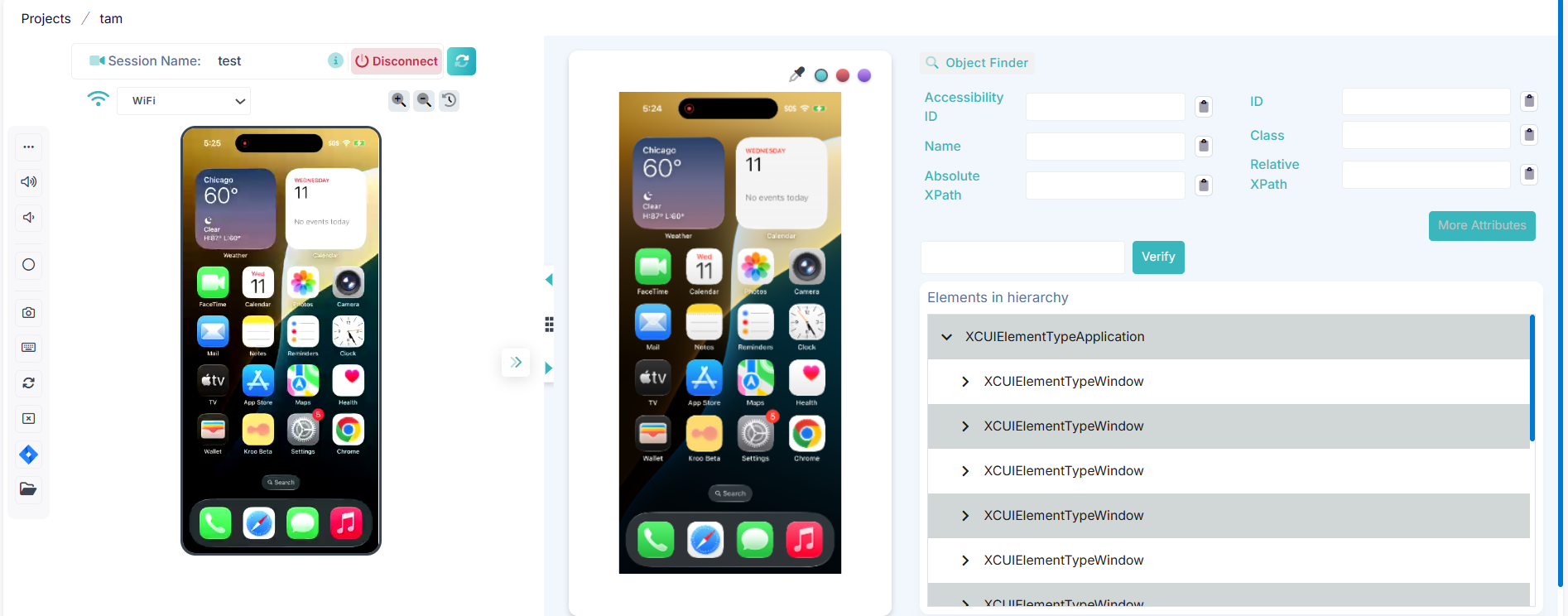
Improvement
Onboarding, Your Way: Global Navbar Adds Flexibility to Your First Steps!
The Problem: Previously, the user onboarding pages existed in a self-contained flow without the main platform’s global navigation bar. This could create a restrictive experience for new users who might start the onboarding process but need to pause, log out, or navigate to another section of the platform before completing it.
The Fix: We have now added the standard global navbar to all user onboarding pages within Qyrus. This provides users with consistent access to main navigation elements throughout the entire setup process.
How does it help? This enhancement provides new users with greater flexibility and control. If a user gets interrupted or wishes to complete the onboarding process at a later time, the navbar gives them a clear and standard way to log out and return later. This improves the overall user experience, reduces potential frustration during initial setup, and makes the platform feel more integrated from the very first interaction.
Improvement
Smarter Self-Healing: Healer 2.0 Gets a Major Accuracy Boost!
The Problem: Previously, the Healer 2.0 functionality might have had difficulty healing locators for elements that were not clearly associated with a traditional anchor element. Furthermore, its healing algorithm sometimes relied more heavily on the natural language step description than the locator itself, which could occasionally lead to less accurate suggestions, especially on pages with multiple similar-looking elements.
The Fix: We have significantly improved the Healer 2.0 engine for Web Testing with two key enhancements:
- Broader Element Recognition: The Healer can now identify and heal locators for elements using common, unique attributes like id, name, and data-testid, even if they aren’t surrounded by a traditional anchor.
- More Precise Healing Logic: The algorithm has been updated to lean more heavily on the attributes of the original failed locator as the primary source of truth. The step description is now used as a powerful secondary tool to pinpoint the correct element, especially in ambiguous cases where multiple potential matches exist.
How does it help? This makes our self-healing capability much more powerful, accurate, and reliable. By better understanding modern web attributes like data-testid and prioritizing the locator’s original intent, Healer 2.0 can now fix a wider range of broken locators with greater precision. This leads to more resilient automated tests that can better withstand minor UI changes, ultimately reducing test flakiness and saving you significant time on maintenance.
Improvement
From Story to Scenario, Instantly: TestGenerator Integrates with Azure DevOps & Rally!
The Problem: Previously, users who manage their development lifecycle with tools like Azure DevOps or Rally had a manual gap in their workflow. They could not directly use our AI-powered TestGenerator to create test scenarios from their user stories, tasks, or bug reports residing in those platforms, requiring them to copy-paste or manually recreate context to generate tests.
The Fix: We have expanded the capabilities of TestGenerator on Web to now support direct integration with Azure DevOps and Rally. This allows users to connect to their accounts on these platforms and select work items (like user stories, tasks, bugs, etc.) as the source for test generation.
How does it help? This integration creates a seamless and powerful bridge between your requirements management and test creation processes. You can now save significant time and effort by automatically generating relevant test scenarios directly from your existing work items in Azure DevOps and Rally. This eliminates manual data transfer, reduces the risk of errors, improves traceability from requirement to test, and dramatically accelerates your workflow from user story to executable test case.
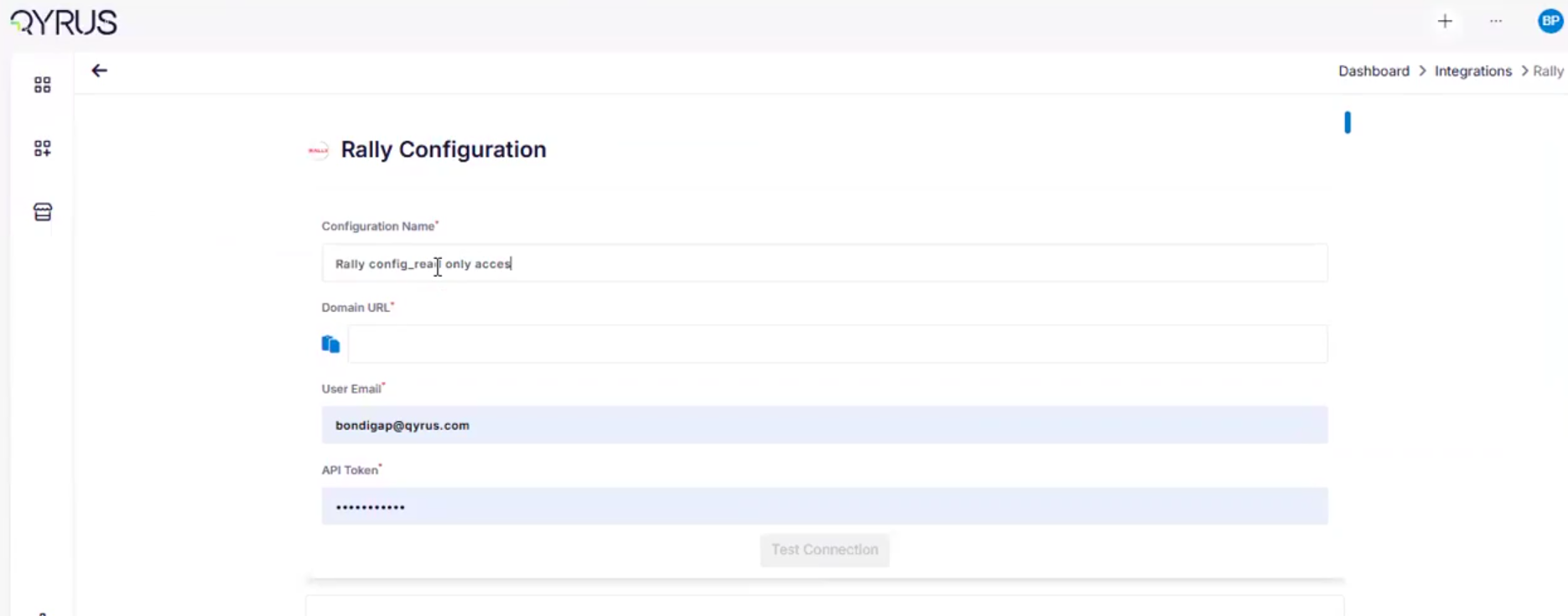
Improvement
From Scenario to Script, Instantly: TestGenerator Now Creates Manual Steps!
The Problem:
Previously, when TestGenerator generated a test scenario (e.g., “Verify user can log in”), it provided the high-level test idea. However, users still had to manually interpret that scenario and write out all the individual, sequential steps required to execute it (e.g., 1. Navigate to URL, 2. Enter username, 3. Enter password, 4. Click login). This manual translation from a test idea to an actionable script was a time-consuming step in the test creation process.
The Fix:
We have significantly enhanced TestGenerator’s capabilities. For every test scenario it generates, it now also automatically creates a complete, logical sequence of Manual Test steps that outlines the flow of the test.
How does it help?
This is a massive workflow accelerator. Instead of just giving you a test idea, TestGenerator now provides an entire, ready-to-use test script blueprint. Your task is simplified from writing steps from scratch to simply validating the generated flow and adding your locators. This dramatically reduces manual effort, speeds up the time it takes to create a runnable automated test, and bridges the gap between a high-level test concept and a concrete, actionable test case.
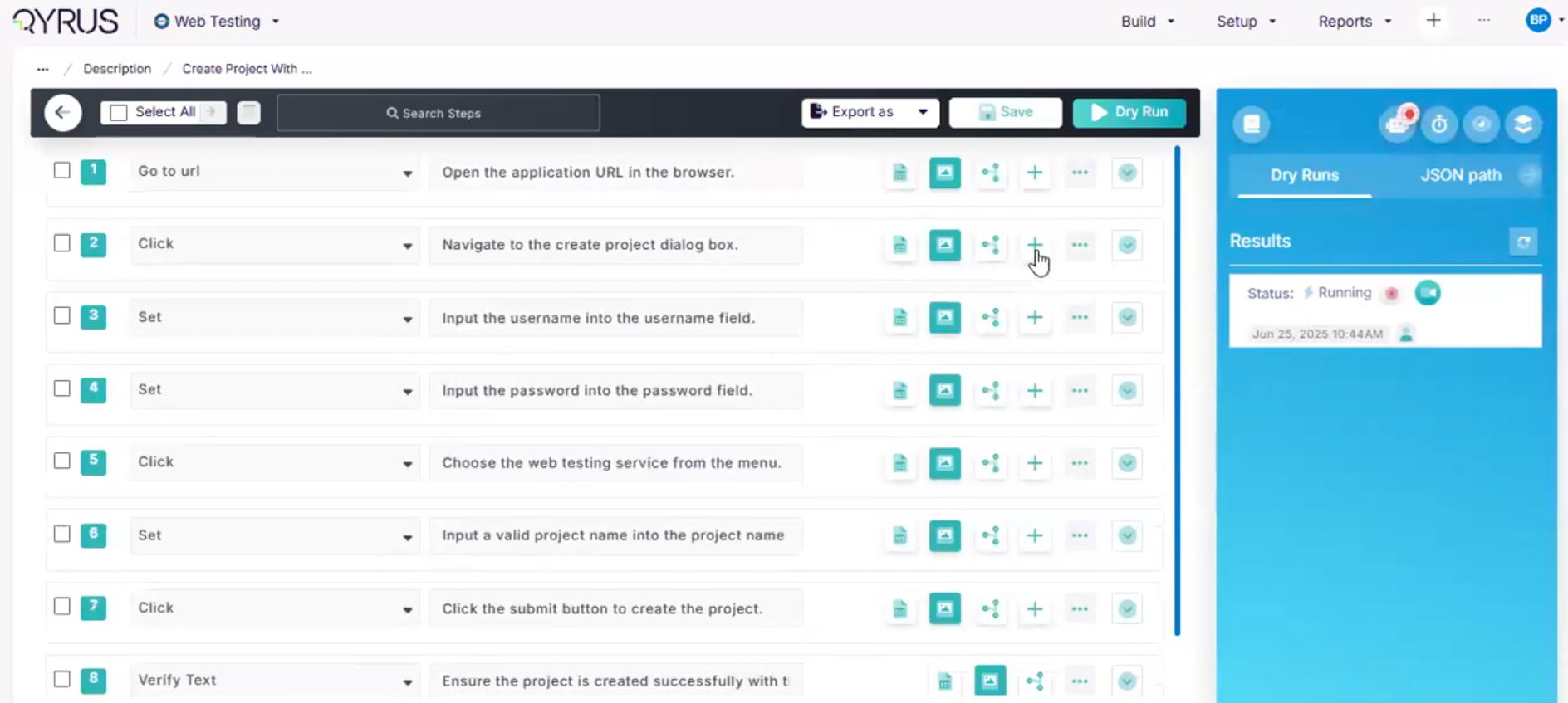
New Feature
Unlock Your Data Lake: Introducing the Azure Data Lake (ADLS) Connector!
The Problem:
Previously, users whose data resided in Azure Data Lake Storage (ADLS) could not directly connect to and utilize that data within our Data Testing Service. This created a significant hurdle, requiring them to perform cumbersome workarounds like manually exporting data from ADLS and importing it into another supported source, which is inefficient and prevents timely data validation.
The Fix:
We have released a new Azure Data Lake Service (ADLS) connector. This connector allows users to establish a direct connection to their ADLS Gen2 storage accounts from within the Qyrus Data Testing Service.
How does it help?
This new connector seamlessly integrates a key component of the Azure data ecosystem into our platform. Users can now directly ingest, compare, and evaluate data residing in their Azure Data Lake without the need for manual data movement. This enables more efficient and timely data quality testing, empowers teams to validate their data directly at the source, and streamlines the entire data testing workflow for organizations utilizing ADLS.
Code Generation for cURL!
Developers and testers can now instantly generate ready-to-use cURL commands from their tested API requests inside qAPI. This makes it easier than ever to integrate third-party APIs directly into your application code or share reproducible examples across teams.
What’s New:
- Generate cURL code snippets for any tested API
- Quickly copy and drop them into your app or CLI
- Improve developer velocity, reduce manual translation errors
This release kicks off our larger Code Generator rollout. Soon, you’ll be able to export code snippets in multiple languages and libraries, including:
- Java: OkHttp, Unirest
- Python: http.client, Requests
- JavaScript: Fetch API
Ready to Accelerate Your Testing with July’s Upgrades?
This July, we’re bringing you deeper workflow integrations, more powerful AI automation, and significant security and performance enhancements designed to streamline your entire testing process. From automatically generating detailed manual test steps with TestGenerator and enabling seamless end-to-end tests with session persistence, to connecting directly with Azure Data Lake and integrating with Azure DevOps and Rally, these updates are built to boost your team’s productivity. We are dedicated to evolving Qyrus into a platform that not only anticipates your needs but also provides practical, powerful solutions that help you release top-quality software with greater speed and confidence.
Curious to see how these July enhancements can benefit your team? There’s no better way to understand the impact of Qyrus than to see it for yourself.




